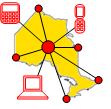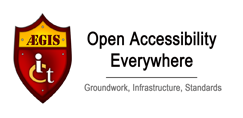Results
![]() Results marked with this icon originate in the ÆGIS (Ontario) project. Other results have originated from the ÆGIS (Europe) project. The point of contact between the two projects is the Inclusive Design Research Centre (IDRC) at OCAD University.
Results marked with this icon originate in the ÆGIS (Ontario) project. Other results have originated from the ÆGIS (Europe) project. The point of contact between the two projects is the Inclusive Design Research Centre (IDRC) at OCAD University.
Software Products
Desktop
 GnomeShell Magnifier (in production, development continues):
GnomeShell Magnifier (in production, development continues):GnomeShell Magnifier is a built-in magnifier for the GNOME Shell desktop on Linux. Our work has involved adding magnification to GNOME 3.4 as well as upcoming improvements in GNOME 3.6 addressing screen enhancement, such as: lightness inversion, RGB contrast/brightness control and crosshairs for mouse tracking. [Screencast 1 | Screencast 2]
 Caribou Onscreen Keyboard (development continued by the Gnome Community):
Caribou Onscreen Keyboard (development continued by the Gnome Community):Caribou is a text entry and UI navigation application being developed as an alternative to the Gnome On-screen Keyboard. The overarching goal for Caribou is to create a usable solution for people whose primary way of accessing a computer is a switch device. [Screencast]
 Next-Generation Java Access Bridge (transitionned to Oracle, development continues):
Next-Generation Java Access Bridge (transitionned to Oracle, development continues):This work involved exploring potential improvements to the Java Access Bridge that allows assistive technologies to communicate with Java applications on the Windows platform.
Web
 Fluid Infusion (in production, development continues):
Fluid Infusion (in production, development continues):FLUID Infusion is a Web 2.0 component set that is built on jQuery with accessibility and usability as top priorities. Fluid Infusion makes use of WAI-ARIA 1.0, which we are also involved in developing (see below) Current release is 1.4. [Fluid Infusion Demo Portal]
 OpenVULab(development continues):
OpenVULab(development continues):OpenVULab is an open source tool designed for remote usability and accessibility research. A unique feature of OpenVULab is that it can record video and audio of remote users’ interactions with their computer without the need to install an application on the users’ computer.
Mobile
 Tecla Access Keyboard (publically available, development continues):
Tecla Access Keyboard (publically available, development continues):The Tecla Access Keyboard is a a software that enables alternative access and text-entry to mobile devices. The keyboard will be used to provide switch-based interfaces for people with motor impairments. Current release is v0.6.1(beta) for Android. [Download Tecla Access] [Screencast]
 tagin! (publicly available, development continues):
tagin! (publicly available, development continues):tagin! is a WiFi-based point-of-interest (POI) annotation service and API that may be used to create context-aware, location-based services (LBS) and applications for outdoor and indoor use. Currently, application developers can use tagin! to post and retrieve addresses, indoor references (room, floor and area), and tags that are specific to the location of their WiFi-enabled devices.
Hardware Products
 Tecla Access Shield (publicly available):
Tecla Access Shield (publicly available):The Tecla Shield is a device that allows powered wheelchairs to be connected to mobile devices via Bluetooth for the purpose of controlling the mobile devices with the wheelchairs' pre-configured switches. [Video]
Contributions to Accessibility Standards
 Accessible Rich Internet Applications (WAI-ARIA) 1.0 (in development):
Accessible Rich Internet Applications (WAI-ARIA) 1.0 (in development):This specification provides an ontology of roles, states, and properties that define accessible user interface elements and can be used to improve the accessibility and interoperability of web content and applications. These semantics are designed to allow an author to properly convey user interface behaviors and structural information in document-level markup, to assistive technologies.
 Authoring Tool Accessibility Guidelines (ATAG) 2.0 (in development):
Authoring Tool Accessibility Guidelines (ATAG) 2.0 (in development):This specification provides guidelines for designing web content authoring tools that are both (1) more accessible for authors with disabilities and (2) designed to enable, support, and promote the production of accessible web content by all authors.
 User Agent Accessibility Guidelines (UAAG) 2.0 (in development):
User Agent Accessibility Guidelines (UAAG) 2.0 (in development):This document provides guidelines for designing user agents that lower barriers to Web accessibility for people with disabilities.
 Status of ARIA Implementation in Windows Browsers:
Status of ARIA Implementation in Windows Browsers:This specification provides an ontology of roles, states, and properties that define accessible user interface elements.
Accessible Software Design Resources
- Accessibility Personas:
Personas are hypothetical archetypes of actual users. Although they are imaginary, they are defined with significant rigour and precision and they are a useful tool for all members of a project team so that developers, designers, managers and other stakeholders can develop a shared understanding of their end-users.
- Use Cases and Application Scenarios (D1.1.3)
- Ethics Manual (D5.6.1a)
Web Sites
 Stretch 2.0 Accessible Art and Design Contest:
Stretch 2.0 Accessible Art and Design Contest:An online design contest for Ontario secondary school art and computing teachers and students that stretches the traditional definition of audience.
Reports
ÆGIS Europe
- A4.6.2, Requirements for mobile device implementation of on-screen keyboard:
Explores the technical feasibility and base requirements for the implementation of an accessible on-screen keyboard (OSK) providing alternative input access for people with motor impairments to mobile devices.
- A4.6.3, Requirements for Incorporating Language Support Features in Mobile Devices:
Outlines the requirements for the development of an accessibility tool for mobile devices that would be optimized for use by people with speech and language impairments.
ÆGIS Ontario
 SP4.3, Evaluation of Strategies for Incorporating Cognitive Aids and Internationalization in Mobile Devices:
SP4.3, Evaluation of Strategies for Incorporating Cognitive Aids and Internationalization in Mobile Devices:Describes the base requirements and technical feasibility for the development of an accessibility tool for mobile devices targeting people with cognitive impairments.
 SP4.4, Strategies for WiFi, RFID integration into geolocation standards:
SP4.4, Strategies for WiFi, RFID integration into geolocation standards:Summarizes potential strategies for the extension of geolocation standards to include local wireless beacon (e.g., WiFi, RFID) data in location object definitions.
 SP4.5, Location Aware Applications for Indoor Accessibility:
SP4.5, Location Aware Applications for Indoor Accessibility:Describes the base requirements and technical feasibility for the development of location-aware application targeting people with visual impairments.


